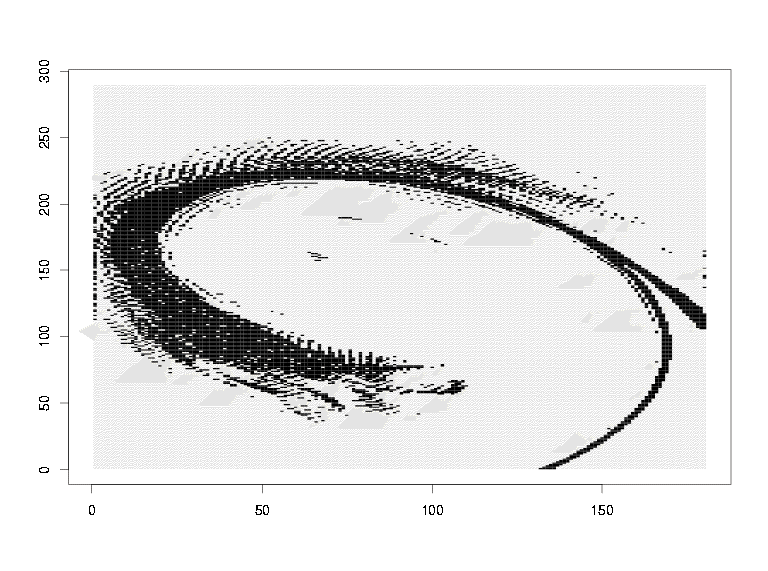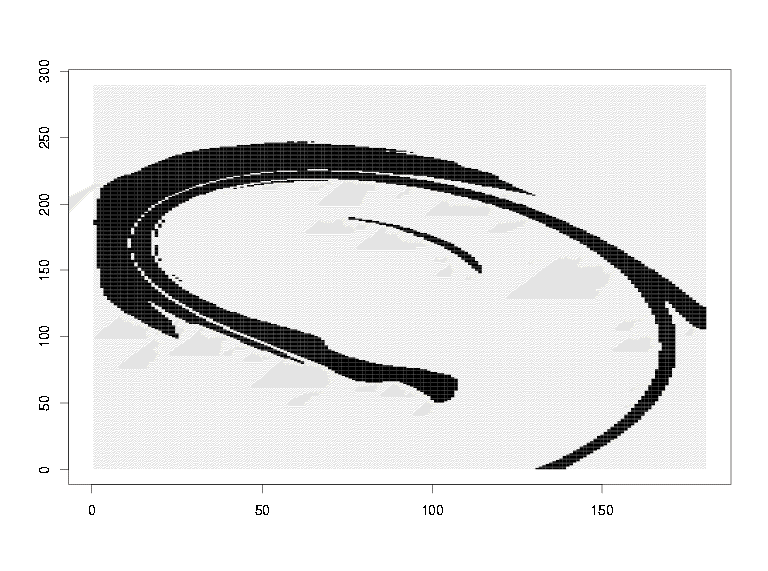
The deep convection parameterization developments, which are now in operational suite (i.e. the downdraft parameterization, the entrainment rate depending on the vertical integral buoyancy, an enhanced detrainment rate at the cloud top, the Gregory-Kershaw approach for momentum convective redistribution, modification of the saturated adiabat computation, limitation of the available humidity for convective updrafts and the treatment of the turbulent fluxes) were intensively tested using the 1D version of the ARPEGE/ALADIN model for the TOGA-COARE case-1. All the tested modifications showed a good potential for solving the convection scheme deficiencies. The problem of the precipitation intermittence and the time step dependency was studied. (NDRL: an important contribution of Doina to the so-called "CYCORA" modifications, see article in this Newsletter).
The 2D model version was used as well to asses the impact of these developments. The model was initialized (horizontally homogenous) by the sounding considered characteristic for the TOGA-COARE case-1 and the convection was initiated by a temperature and humidity perturbation (see: GCSS Working Group on Precipitating Connective Cloud Systems Model Intercomparison: Tropical Oceanic Convection of TOGA-COARE, case 1, http:/cnrm.meteo.fr). Even if the model was not able to simulate correctly the evolution of the squall line ( for the horizontal resolution about 7.3 km) the introduction of the above modifications increased the "life" time of convective activity.
The 3D simulations of the squall line of July 21, 1992 (CLEOPATRA case) were used for tuning the free parameters of the convection scheme. The results have shown more realistic features of the squall line structure for high resolution. There are still some problems for "intermediate" horizontal resolution (for instance about 12 km) when the displacement speed is too high. A first attempt to make the precipitation fraction evaporated to produce the downdraft dependent of the vertical wind shear was done.
During the last period the work was concentrated on completing the trajectory scheme for the 3D model. The horizontal acceleration contains two parts - dynamical and physical tendencies. They both must be present. The physical tendencies has been introduced in the code for obtaining the SL trajectories and it has been tested. The result was stable behavior with minor impact of the new terms.
The more interesting part of the work was concentrated on the vertical SL trajectory computation. In the environment of a hydrostatic model there is no tendency for the vertical velocity since the momentum equation on vertical is reduced to hydrostatic diagnostic one. Thus only uniform motion is assumed on vertical. However it is valid only in case of regular z coordinate. In the case of nonlinear hybrid s vertical coordinate an acceleration term appears which can be analytically derived. There is no physical tendencies on vertical. The new vertical acceleration computations has been introduced in the code and tested. Stability of the new developments has been proved. However work has still to be done in order to prove accuracy of the latest modifications.
The perspectives for the next three months include some more work on two problems. The first one is to make some tests with the "Shallow Water" version of the global model and prove conservation of the trajectory scheme. The second is to test the 3D trajectory scheme on a particular strong case where the vertical part of the trajectory computations would be important and eventually prove accuracy.
The work is at a stage that in developed ideal 3D frontogenetic framework are tested different sL interpolators. As a first step, the already implemented interpolators have been tested. By extending the time-step to almost the limit of stability of sL scheme it was possible to obtain states where one tested case failed while another was producing almost reasonable results. This stage was considered as a testing tool for the forthcoming research. The failed case will be denoted like case 2 (because all NxLAG switches are set to value 2) while the successful case will be denoted as the case 3. (The case 3, i.e. NxLAG=3 corresponds with the operational configuration.)
The assumption had been defined that just several points from the case 2 are responsible for the failure and to interpolate sL amount for them by interpolator used for case 3 will revert the failure to the result identical with the case 3. The only thing was to define such criterion according that the interpolators would be applied.
By chance taken criterion as absolute horizontal wind speed was working when about 30% of points were interpolated by the more diffusive (and less accurate interpolator). The conclusion of that is that assumption is right and such criterion must exist. Next step was just to define such criterion which is supposed to be a function of derivatives of the flow field.
Several authors recommended different combinations for such criterion (Lipschwitz condition, Pudykiewicz et al.(1985), Sadourny and Maynard(1995),...) so we were testing all of them but with no one a successful result has been obtained. Such criterions defined according spectral derivatives were not able to fully revert the case 2 to case 3 even when applied the more diffusive interpolator to more than 50% of points.
Several things were tested to avoid this unpleasant situation and finally it has been found that two things were responsible for the failure of the suggested method which is theoretically correct. The first one was the fact that in strong flow along frontal zone stationary waves were propagating affecting through derivatives as well the criterion and as a consequence such criterion was not able to act at the proper points. This problem was cured by adding some decentralization to the 3TL sL scheme used. The second problem is coming from the fact that ALADIN model is a spectral one. To study such phenomena as the frontal collapse in spectral model logically create well known Gibbs effect on all fields near the frontal zone. This effect is spoiling not only the values of fields itself but mainly field derivatives. For the normal hydrostatic sL computation the flow derivatives are not used but in this case when taken to determine the criterion the effect of the Gibbs waves is really well visible. To avoid the influence of it to the criterion, the criterion were computed from the centered difference of a smoothed flow field. The field of flow was smoothed with a Gauss weights which is usually used to damp Gibbs effect. This works almost perfect the only disadvantage of this method is loose of computing efficiency due to the smoothing process. The CPU time has increased about 10 times which can be slightly decreased by more effectively written code but not to the state comparable with current time used for model computation. Another solution to avoid the Gibbs effect is to use instead of quadratic truncation just the linear one. This will be studied.
Nevertheless to use decentering and smoothed flow fields to compute flow derivatives was enabling to revert case 2 to one identical with case 3 acting by more diffusive interpolator to no more than just 15% of points. (This amount is measured just for the most sL "problematic" layer so there is a good assumption that for the whole atmosphere it can be even less points to be necessary to cure.) As a probably best theoretically grounded criterion, has been taken the total deformation of the horizontal wind field which works really fine.
The next step will be to extend this switching method between just two already implemented interpolators to some more general method enabling for example combination of several interpolators. Some research to make computation of the criterion more efficient is also necessary. Then probably will be the time to compare the effect of this flow dependent diffusion method with the real horizontal diffusion in model.
The following figures are illustrating the criterion for the lowest model level (i.e. level when frontal zone reach the highest values of gradients) after 12 hours of integration computed as just the deformation of flow field (Figure1) and the same criterion computed from the smoothed flow field and with decentering dumping the stationary waves during the model integration (Figure2). From the second figure is possible to find that even after smoothing the bigger Gibbs waves are remaining (note the white ring inside the black area) but it is not strong enough to spoil the results of model integration.

Figure 1

Figure 2
Report in the Newsletter 14 and PhD to be defended in january 2000. More details at that occasion (Newsletter 17)
 |
Home |